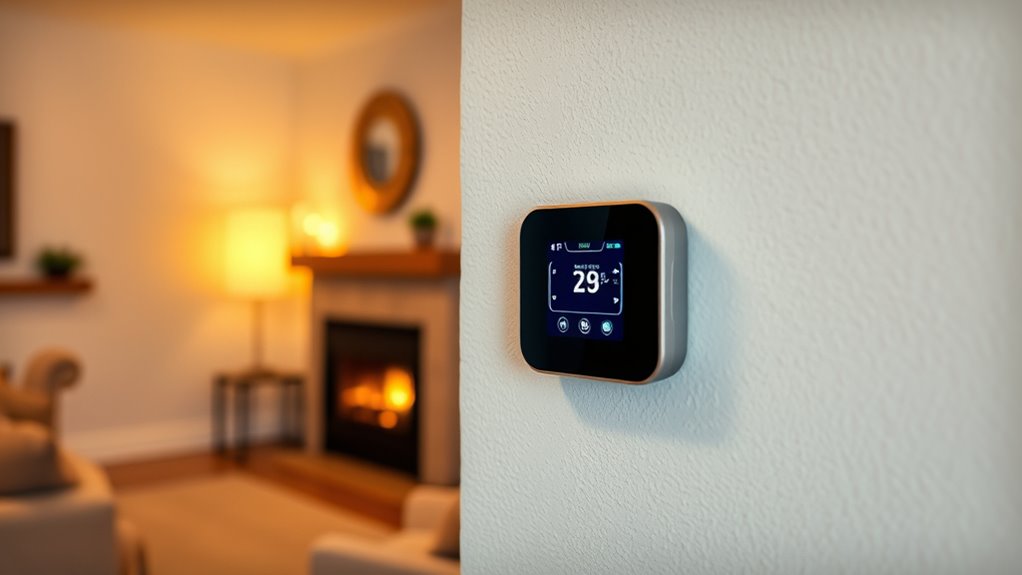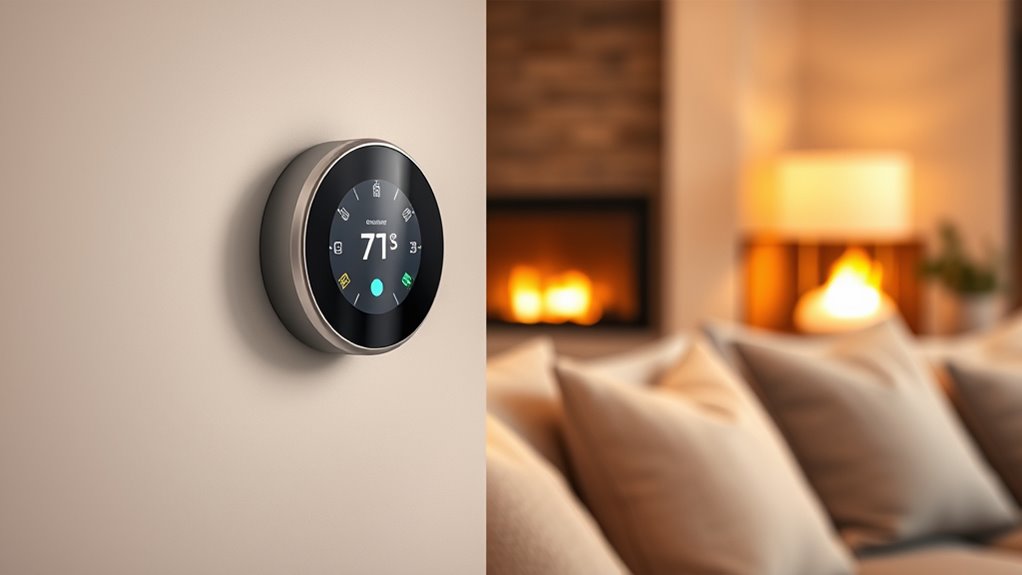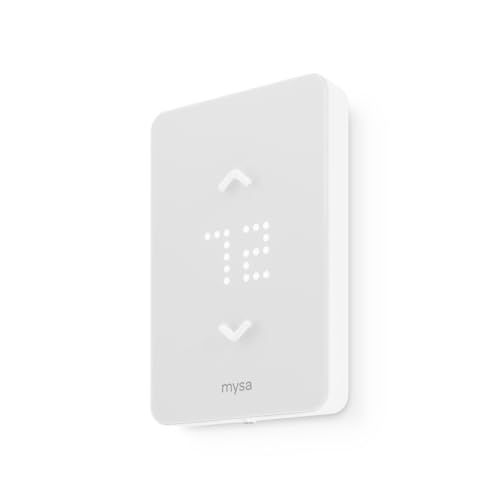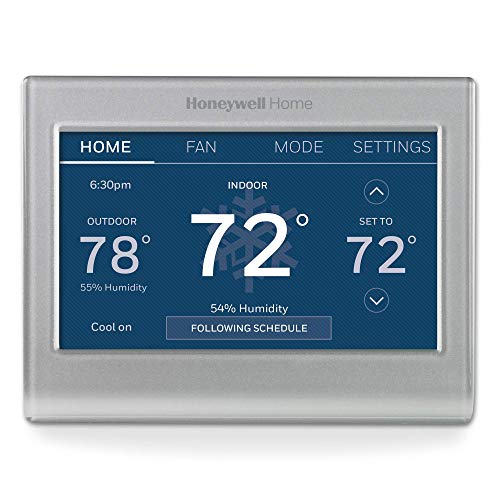If you’re looking for the best smart thermostats for heat-only systems, I’ve found several reliable options like ecobee, Mysa, and Sensi that offer easy installation, smart features, and compatibility with various heating systems. These thermostats can help save energy while keeping your home cozy with scheduling, remote control, and automation. Keep going to discover how these models and tips can make your heating smarter and more efficient.
Key Takeaways
- These thermostats are designed specifically for heat-only systems like electric baseboards, boilers, and furnaces with line voltage compatibility.
- Many models support remote control, scheduling, occupancy sensing, and automation to enhance home comfort and energy efficiency.
- Compatibility varies; verify wiring needs (C-wire or Power Extender Kits) and voltage requirements before installation.
- Integration with voice assistants (Alexa, Google, Siri) and smart home platforms allows convenient control and automation.
- Top options include models like ecobee and Mysa, which offer easy DIY installation, modern design, and energy-saving features.
Sensi Smart Thermostat
If you’re looking for a smart thermostat that’s easy to install and compatible with most heat-only systems, the Sensi Smart Thermostat is an excellent choice. It features a simple, traditional design with buttons, fitting seamlessly into standard thermostat spaces without patching or painting. Many models don’t even need a c-wire, making DIY installation straightforward with clear app instructions and built-in level guidance. Wi-Fi connectivity and a mobile app let you control your heating remotely, while ENERGY STAR certification helps cut energy use by around 23%. Plus, it offers smart maintenance alerts, usage reports, and works with Alexa for voice control, ensuring your home stays cozy and efficient.
Best For: homeowners seeking an easy-to-install, energy-efficient smart thermostat compatible with most heat-only systems and featuring remote control via Wi-Fi and voice commands.
Pros:
- Easy DIY installation with built-in level and step-by-step app instructions
- Compatible with most HVAC systems, often without requiring a c-wire
- ENERGY STAR certified, helping reduce energy consumption by about 23%
Cons:
- May not be suitable for complex or multi-stage HVAC systems
- Limited to heat-only systems, not compatible with cooling or multi-zone setups
- Some users might prefer more advanced smart home integrations beyond Alexa
Sensi Lite Smart Thermostat
The Sensi Lite Smart Thermostat by Emerson stands out as an excellent choice for homeowners seeking an affordable, easy-to-install device that offers reliable energy savings. It features simple wall mounting, an LCD display, and a sleek black design that fits well in most homes. Compatible with HVAC systems like furnaces, boilers, heat pumps, and air conditioners, it supports automatic and programmable temperature control. With Wi-Fi connectivity, you can control it remotely via the app on Android or iOS devices, and it integrates with Alexa, Google Assistant, and SmartThings. Overall, it’s a user-friendly, cost-effective option that helps you save energy while maintaining comfort.
Best For: homeowners seeking an affordable, easy-to-install smart thermostat that offers reliable energy savings and remote control capabilities.
Pros:
- Simple DIY installation with clear instructions and built-in level
- Compatible with most HVAC systems, including air conditioners, furnaces, boilers, and heat pumps
- Supports remote management via app and integrates with Alexa, Google Assistant, and SmartThings
Cons:
- Wi-Fi connectivity issues reported by some users, affecting remote control functionality
- Limited compatibility outside North America, with some restrictions on integration in certain regions
- Occasional reports of touchscreen failure after extended use
Ecobee Smart Thermostat Premium with Sensors and Air Quality Monitor
Designed for homeowners seeking both energy savings and advanced home monitoring, the Ecobee Smart Thermostat Premium with Sensors and Air Quality Monitor stands out as an excellent choice. It can reduce heating and cooling costs by up to 26% annually and is ENERGY STAR certified, emphasizing efficiency. Features like open window detection automatically pause HVAC when a door or window stays open for five minutes, saving money and protecting the environment. With built-in air quality sensors, it alerts you to poor air conditions and offers improvement tips. Its compatibility with most 24VAC systems, easy installation, and smart app controls make it a versatile, eco-friendly upgrade for any home.
Best For: homeowners seeking an energy-efficient, smart thermostat with advanced air quality monitoring and home security features.
Pros:
- Helps reduce heating and cooling costs by up to 26% annually, promoting savings.
- Built-in air quality monitoring with alerts and tips for improving indoor air conditions.
- Compatible with most 24VAC HVAC systems and supports voice control through Amazon Alexa, Siri, Google Assistant, and more.
Cons:
- Installation may require technical knowledge or professional assistance for some users.
- Regional limitations may affect location-based features and settings.
- The device’s advanced features and sensors come at a higher price point compared to basic thermostats.
Schluter Ditra-Heat-E-RS1 Smart Thermostat with Floor Sensors
For homeowners seeking a sleek, modern thermostat to control floor heating, the Schluter Ditra-Heat-E-RS1 stands out with its stylish mirror-finish design. Its reflective glass surface adds a contemporary touch, though it can be tricky to read in certain lighting and tends to show smudges. This wall-mountable device offers a backlit LCD display and touchpad controls, making it easy to operate. Compatible with Alexa and Google Home, it integrates seamlessly into your smart home setup via Wi-Fi. The thermostat manages DITRA-HEAT-E-HK cables, includes dual sensors, and features energy tracking. Despite some usability drawbacks, its modern aesthetic and smart features make it a popular choice for floor heating control.
Best For: homeowners seeking a sleek, modern, Wi-Fi-enabled smart thermostat for controlling floor heating systems with energy monitoring features.
Pros:
- Stylish mirror-finish design adds a contemporary aesthetic to modern interiors
- Compatible with Alexa and Google Home for seamless smart home integration
- Includes dual sensors and energy tracking for efficient temperature management
Cons:
- Mirror surface can be difficult to read under certain lighting conditions and shows smudges easily
- Limited features compared to models with color screens and advanced sensors
- Some users report device failures within a year, with manufacturer repair refusals when purchased through third-party vendors
Amazon Smart Thermostat
If you want an affordable, easy-to-install smart thermostat that integrates seamlessly with Alexa, the Amazon Smart Thermostat is an excellent choice. Made with Honeywell technology, it supports most 24V HVAC systems, including force air, heat pumps, and radiant boilers. It requires a C-wire or power adapter (sold separately). The compact design and simple setup via the Alexa app make it user-friendly. With features like scheduling, humidity sensing, and energy dashboards, it helps optimize comfort and save energy. The thermostat’s Alexa compatibility allows for voice control and automations, providing a smart, budget-friendly solution for heat-only systems.
Best For: budget-conscious homeowners seeking a simple, Alexa-compatible smart thermostat with easy installation and energy-saving features.
Pros:
- Affordable price point with potential rebates and incentives
- Seamless integration with Alexa for voice control and automation
- Easy, guided setup via the Alexa app with a sleek, compact design
Cons:
- Requires a C-wire or separate power adapter for installation
- Occasional connectivity issues after power outages or on older Android devices
- Documentation and installation instructions may require additional research for some HVAC systems
ecobee Smart Thermostat Enhanced – Programmable WiFi Thermostat
The ecobee Smart Thermostat Enhanced stands out for its advanced energy-saving features, making it an excellent choice for homeowners seeking to reduce heating costs without sacrificing comfort. It automatically adjusts temperatures based on occupancy, suggests schedule changes, and preheats or precools your home before you arrive. Compatible with most 24 VAC systems, it supports gas, oil, electric, dual fuel, heat pumps, and boilers. The device includes a Power Extender Kit for easy installation without a C-wire and offers app control, voice integration, and humidity adjustment. With a sleek design and a 3-year warranty, it’s a reliable, energy-efficient option for heat-only systems.
Best For: homeowners seeking an energy-efficient, versatile smart thermostat compatible with a variety of HVAC systems and looking for remote control and automation features.
Pros:
- Automates temperature adjustments based on occupancy and schedules to maximize energy savings.
- Supports a wide range of HVAC systems, including those without a C-wire, thanks to the Power Extender Kit.
- Compatible with multiple smart home platforms such as Alexa, Google Assistant, Apple HomeKit, and IFTTT for seamless integration.
Cons:
- Installation may be complex without professional help, especially for systems lacking a C-wire.
- The standby display turns off when approached, which can be inconvenient for quick glances.
- Repeated logins are required for the web interface, which some users find less user-friendly.
Mysa Smart Thermostat LITE for Baseboard Heaters
The Mysa Smart Thermostat LITE stands out as an ideal choice for homeowners seeking to optimize cost savings and comfort with their baseboard heating systems. It’s a sleek, Wi-Fi-enabled thermostat compatible with 120V-240V electric baseboard, fan-forced, wall, and convector heaters. With easy DIY installation, you can replace standard thermostats in about 15 minutes. The thermostat allows you to create custom schedules, reduce energy use when away, and control your system remotely via a free smartphone app. Plus, it works seamlessly with voice assistants like Siri, Alexa, and Google Assistant, making heating management simple and efficient.
Best For: homeowners looking to enhance energy efficiency and convenience with their electric baseboard or wall heaters through easy installation and remote control.
Pros:
- Easy DIY installation in approximately 15 minutes without professional help
- Compatible with multiple voice assistants including Siri, Alexa, and Google Assistant
- Creates customizable schedules to optimize heating and reduce energy costs
Cons:
- Limited to 120V-240V electric heating units, not compatible with other types of heating systems
- Requires a Wi-Fi connection for full functionality, which may be an issue in areas with poor connectivity
- Basic model may lack some advanced features found in higher-end thermostats
Honeywell Home Smart Thermostat with WiFi
Designed for conventional and heat pump systems, the Honeywell Home Smart Thermostat with WiFi stands out as an excellent choice for homeowners seeking reliable remote control and smart features. It’s ENERGY STAR and Matter certified, ensuring compatibility with Alexa, Google, and Apple HomeKit. The thermostat offers flexible scheduling, auto-away, humidity monitoring, and filter reminders, all controllable via app, voice, or buttons. Setup is straightforward if you have a C-wire, but some may need an adapter. While the app can be tricky, the device’s sturdy build and easy integration make it a solid, affordable option for those wanting smart control over their heat-only systems.
Best For: homeowners seeking a reliable, easy-to-integrate smart thermostat compatible with popular voice assistants and existing conventional or heat pump HVAC systems.
Pros:
- Easy installation and setup, especially with existing C-wire wiring.
- Compatible with Alexa, Google Assistant, and Apple HomeKit for versatile smart home integration.
- Features flexible scheduling, humidity monitoring, and remote control via app or voice commands.
Cons:
- App interface can be confusing and occasionally unstable, affecting user experience.
- Some users experience WiFi connectivity issues requiring troubleshooting.
- Limited advanced control through Apple HomeKit, with most features accessible only via the app.
ecobee Smart Thermostat Essential – Wi-Fi Programmable Thermostat
If you’re looking to save energy and improve comfort with minimal hassle, the ecobee Smart Thermostat Essential is an excellent choice for heat-only systems. It can cut your heating and cooling costs by up to 23% annually by automatically adjusting to your schedule, saving energy when you’re away and boosting comfort when you’re home. Installation is straightforward, no C-wire needed if you use the ecobee Power Extender Kit. You can control it via a color touchscreen or the ecobee app, and it seamlessly integrates with Apple HomeKit, Google Assistant, and Alexa. Plus, it’s Energy Star certified for efficiency and reliability.
Best For: homeowners seeking an easy-to-install, energy-efficient thermostat that seamlessly integrates with smart home ecosystems and requires minimal wiring for heat-only HVAC systems.
Pros:
- Saves up to 23% annually on heating and cooling costs through automated scheduling and energy tracking.
- Easy DIY installation with no C-wire needed when using the Power Extender Kit.
- Compatible with leading smart home platforms like Apple HomeKit, Google Assistant, and Alexa, offering flexible control options.
Cons:
- Primarily designed for heat-only systems; may have limited features for cooling or multi-stage HVAC setups.
- Compatibility with some HVAC systems may require checking via the ecobee Compatibility Checker.
- Limited physical interface options beyond the color touchscreen and app control; no traditional thermostat buttons.
RTH9585WF1004 Wi-Fi Smart Color Thermostat
For homeowners seeking a customizable and energy-efficient thermostat, the RTH9585WF1004 Wi-Fi Smart Color Thermostat stands out thanks to its vibrant, easy-to-read touchscreen and flexible scheduling options. Its bright display can be personalized with different colors to match your décor, making it both functional and stylish. Compatible with various heating systems like gas, oil, electric, hot water, steam, and heat pumps with electric backup, it offers tailored scheduling to conserve energy during peak times. Wi-Fi connectivity and Alexa compatibility allow remote control and voice commands, while ENERGY STAR certification ensures efficiency. Plus, you can track your energy use and access utility rebates for additional savings.
Best For: homeowners looking for a customizable, energy-efficient smart thermostat with remote control and voice integration.
Pros:
- Vibrant, customizable color display that matches home décor
- Flexible scheduling options for personalized comfort and energy savings
- Compatible with a variety of heating systems and supports Wi-Fi and Alexa for remote and voice control
Cons:
- Does not support electric baseboard heat (120-240V) without additional C-wire adapter
- Requires a C-wire for installation, which may not be available in all homes
- Some advanced features may require familiarity with smart home integrations or utility rebate programs
Mysa Smart Thermostat for Electric Baseboard Heaters
The Mysa Smart Thermostat stands out as an excellent choice for homeowners with high-voltage electric baseboard heating systems, especially those seeking precise control and energy savings. It’s designed for 120–240V systems like baseboards, convectors, and radiant heaters, supporting loads up to 1900W at 120V or 3800W at 240V. Installation is straightforward, guided by the app, and typically takes 5–15 minutes. With features like scheduling, geofencing, voice control, and energy insights, it offers both convenience and efficiency. The sleek, wall-mountable design blends seamlessly into your home, making it an ideal solution for modern electric heating setups.
Best For: homeowners with high-voltage electric baseboard heating systems seeking precise control, energy savings, and smart home integration.
Pros:
- Easy installation with clear app-guided wiring and setup
- Supports scheduling, geofencing, voice control, and energy insights for enhanced convenience and efficiency
- Sleek, wall-mountable design that blends seamlessly into various home decor
Cons:
- May require troubleshooting wiring, especially switching black wires during installation
- Scheduling adjustments can be slightly unintuitive for some users
- Not compatible with low-voltage or two-wire heating systems
SunTouch SunStat CommandPlus Wi-Fi Thermostat for Electric Heating Systems
When searching for a smart thermostat tailored to electric radiant floor heating, the SunTouch SunStat CommandPlus stands out thanks to its intuitive touchscreen interface and all-inclusive features. With a sleek 4.3-inch digital display, it offers easy control over 7-day schedules, ‘away’ modes, and energy monitoring. Its floor and air sensing guarantee ideal comfort, while smartStart technology pre-warms floors for scheduled times. Remote access via the free Watts Home app allows me to adjust settings from anywhere. Backed by over 30 years of expertise, SunTouch delivers reliable, user-friendly solutions that keep my home cozy, safe, and energy-efficient.
Best For: homeowners and contractors seeking a sleek, feature-rich Wi-Fi thermostat specifically designed for electric radiant floor heating systems.
Pros:
- Intuitive 4.3-inch touchscreen display for easy programming and control
- Advanced features like floor and air sensing, SmartStart technology, and energy monitoring
- Remote access via the free Watts Home app provides convenient control from anywhere
Cons:
- Primarily designed for electric radiant floor heating, limiting compatibility with other HVAC systems
- Requires Wi-Fi connection and smartphone app for full remote features, which may be a barrier for some users
- May be more expensive compared to basic thermostats without advanced smart features
Sensi Touch 2 Smart Thermostat with Touchscreen Display
If you want a smart thermostat that combines a user-friendly touchscreen with reliable performance, the Sensi Touch 2 is an excellent choice. It features a color display, Wi-Fi connectivity, and programmable settings to help you customize your comfort. Compatible with Sensi Room Sensors (sold separately), it guarantees balanced temperatures across rooms. It works with Alexa for voice control and promotes energy savings, helping you cut HVAC costs by about 23%. Easy to install with a top-rated app and universal Bluetooth tech, it fits most systems (C-wire required). Plus, it prioritizes privacy and provides smart maintenance alerts, making it a practical, efficient upgrade for your home.
Best For: homeowners seeking an easy-to-install, energy-efficient smart thermostat with advanced features and reliable performance.
Pros:
- User-friendly touchscreen display with customizable interface
- Compatible with various smart home systems including Alexa
- Helps reduce HVAC energy costs by approximately 23%
Cons:
- C-wire required for installation, which may not be available in all homes
- Sensi Room Sensors are sold separately, adding to the total cost
- May require a smartphone app for full setup and configuration
Schluter Ditra-Heat-E-WiFi Thermostat with Floor Sensor
For homeowners seeking precise floor heating control, the Schluter Ditra-Heat-E-WiFi Thermostat with Floor Sensor stands out as a top choice. It features a sleek touchscreen interface, supports both 120V and 240V wiring, and includes a floor temperature sensor for accurate heat regulation. With Wi-Fi connectivity, you can control it remotely via the “E heat” app, integrate with Alexa, and set schedules easily. It offers a temperature range up to 80°F+, ensuring warmth and comfort. Built-in safety features like a GFCI protect against shocks, and its straightforward installation process makes it a reliable, energy-efficient solution for modern home heating.
Best For: homeowners seeking precise, remote-controlled floor heating management with smart home integration and safety features.
Pros:
- User-friendly touchscreen interface with easy setup and control
- Supports both 120V and 240V wiring for versatile installation
- Includes safety features like GFCI and temperature regulation up to 80°F+
Cons:
- Occasional login issues and low-resolution display may affect user experience
- Loud clicking sounds when turning on can be disruptive in quiet environments
- Limited compatibility, supporting only Amazon Alexa and not Google Assistant
UDG4 Touchscreen Programmable Floor Thermostat with GFCI
The UDG4 Touchscreen Programmable Floor Thermostat with GFCI stands out as an ideal choice for homeowners seeking a safe and user-friendly control system for electric radiant floor heating. Its 3.5-inch color touchscreen makes programming straightforward, supporting 7-day schedules and an intuitive install wizard. With dual voltage and sensing for both air and floor, it’s versatile across various flooring types. Safety features like Class A GFCI and floor temperature limits safeguard your home. Plus, functions like Vacation Mode, Child Lock, and power logging help optimize energy use and enhance control. Overall, it combines safety, convenience, and efficiency in a sleek, reliable package.
Best For: homeowners seeking a safe, easy-to-use programmable thermostat for electric radiant floor heating with versatile flooring compatibility and energy management features.
Pros:
- Intuitive 3.5-inch color touchscreen with easy programming and scheduling
- Safety features including Class A GFCI and floor temperature limits
- Supports dual voltage and sensing for both air and floor, suitable for various flooring types
Cons:
- May require professional installation for optimal setup and wiring
- Limited to electric radiant floor heating systems, not compatible with other heating types
- Advanced features like power logging might be unnecessary for basic users
Factors to Consider When Choosing Smart Thermostats for Heat‑Only Systems

When selecting a smart thermostat for heat-only systems, it’s important to take into account compatibility with your heating setup and wiring requirements. You also want features like reliable connectivity, energy-saving options, and straightforward installation. Let’s explore these factors to help you choose the best fit for your home.
Compatibility With Heating System
Choosing a smart thermostat for a heat-only system requires verifying its compatibility with your specific setup. First, ensure the thermostat supports single-stage heat-only systems like electric baseboards, boilers, or furnaces. Check that it matches your system’s voltage—most heat-only systems operate on line voltage (120V or 240V)—and avoid thermostats designed for low-voltage wiring. Confirm whether a C-wire is necessary; many heat-only systems don’t need one, but some might require additional wiring or a power adapter. Also, verify that the thermostat can handle your system’s power load, especially if you have high-wattage electric heaters or boilers. Finally, review the manufacturer’s specs to make certain it’s explicitly designed for heat-only systems and doesn’t support cooling or multi-stage configurations.
Wiring and Power Needs
Because wiring and power supply are critical for reliable operation, I always consider whether a smart thermostat for a heat-only system has the necessary connections. Most require a C-wire or an alternative power solution like a Power Extender Kit to provide continuous power. Some models can operate on low voltage or batteries, which might eliminate the need for a C-wire, but they often have limitations in functionality or stability. The absence of a compatible power source can lead to connectivity issues, inaccurate readings, or system malfunctions. It’s essential to verify your existing wiring matches the thermostat’s power requirements before installation. Proper wiring ensures consistent performance and avoids troubleshooting headaches down the line. Always check if your system supports the thermostat’s power needs first.
Connectivity and App Control
Ensuring your smart thermostat supports reliable Wi-Fi connectivity is essential for seamless remote control and system management. A stable connection allows you to adjust settings, monitor your system, and receive alerts from anywhere. Make sure the thermostat’s app is compatible with your preferred platform, whether iOS or Android, and offers intuitive scheduling and monitoring features. The app should provide real-time alerts, usage reports, and maintenance reminders to help optimize your heating efficiency. Voice control compatibility with Alexa, Google Assistant, or Apple HomeKit adds convenience, letting you operate your thermostat hands-free. Additionally, check that the app includes strong security features, such as data privacy protections and secure login protocols, to keep your personal information safe. A reliable app experience is key to maximizing your thermostat’s benefits.
Energy Saving Features
Smart thermostats equipped with energy-saving features can substantially reduce heating costs without sacrificing comfort. I look for models with programmable scheduling and geofencing, which adjust heating based on occupancy and time, optimizing energy use. Energy monitoring reports and real-time usage data help identify unnecessary heating, so I can make smarter decisions. Choosing thermostats certified by ENERGY STAR ensures they meet strict efficiency standards and can save up to 23-26% on heating energy. Features like automatic temperature adjustments and eco modes further minimize energy consumption while maintaining comfort. For heat-only systems, it’s essential that the thermostat has specific control algorithms and sensors to operate efficiently. These features work together to keep my home warm while helping me save on energy bills.
Ease of Installation
When choosing a smart thermostat for a heat-only system, ease of installation is a key factor to contemplate. Many models support DIY setup, with built-in levels and step-by-step app instructions that make installation straightforward. Compatibility with existing wiring, especially the presence of a C-wire, greatly influences how simple the process is. Some thermostats offer wireless or C-wireless options using power extender kits, which can be a game-changer in homes lacking a dedicated C-wire. Typically, installation involves fewer steps and takes less than 30 minutes, making it accessible even for beginners. Clear, detailed guides and intuitive apps further simplify setup, ensuring you can enjoy your new smart thermostat without unnecessary hassle or professional help.
Frequently Asked Questions
Do These Thermostats Support Multi-Zone Heating Setups?
Yes, many of these thermostats support multi-zone heating setups. I’ve found that models like the Nest Learning Thermostat and Ecobee SmartThermostat offer multi-zone control options, allowing me to manage different areas of my home independently. This feature helps me save energy and keeps each room comfortably warm. Just make sure to verify the specific compatibility and installation requirements for your heat-only system to guarantee seamless multi-zone functionality.
Can They Be Integrated With Voice Assistants Like Alexa or Google Assistant?
Ever wondered if these thermostats can work with voice assistants? Yes, they typically support Alexa and Google Assistant integration, making it easy to control your home’s temperature hands-free. I love how seamless it is to adjust settings or check the temperature without getting up. Just guarantee your thermostat is compatible and connected to your Wi-Fi. Isn’t it convenient to have your home climate managed effortlessly?
Are There Any Compatibility Issues With Older Heating Systems?
Older heating systems can sometimes pose compatibility issues with smart thermostats, especially if they lack modern wiring or control interfaces. I recommend checking the thermostat’s compatibility list before buying, or consulting a professional to verify proper installation. In my experience, some models work seamlessly with older setups, but others might require additional wiring or adapters. Always double-check to avoid surprises and ensure your home stays cozy without technical hiccups.
How Secure Are These Thermostats Against Cyber Threats?
These thermostats are generally quite secure, especially when I follow best practices like strong, unique passwords and regular software updates. Most manufacturers include robust encryption to protect your data and prevent unauthorized access. However, I stay cautious by enabling two-factor authentication and avoiding public Wi-Fi connections. Overall, with proper security measures, I feel confident that my smart thermostat keeps my home cozy without risking cyber threats.
What Is the Typical Installation Process for These Smart Thermostats?
Installing a smart thermostat is usually straightforward. I start by turning off the power to my heating system, then remove the old thermostat. I connect the new thermostat’s wires to the corresponding terminals, following the manufacturer’s instructions. Once wired, I mount it on the wall, turn the power back on, and follow setup prompts. It’s a simple process that typically takes 30 minutes, and I find it very manageable.
Conclusion
Choosing the right smart thermostat can truly make a difference in keeping your home cozy and efficient. With so many options tailored for heat-only systems, it’s important to weigh features and compatibility. Remember, the right tool can turn your house into a warm sanctuary. Don’t put all your eggs in one basket—take your time, do your homework, and pick the thermostat that best fits your needs. Your comfort is worth the effort!

























